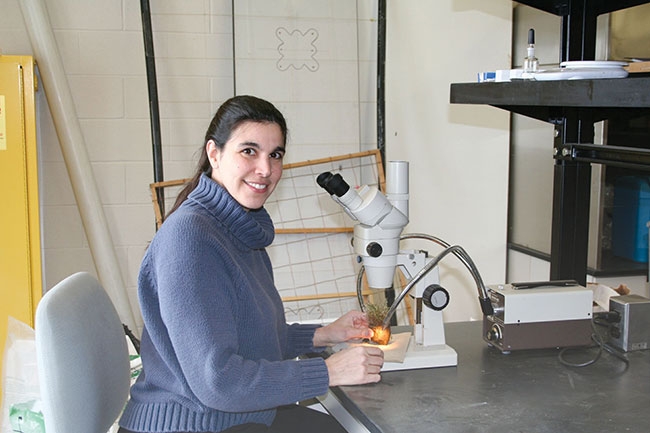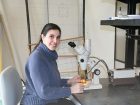
Features
Agronomy
Biosolid research has bright outlook
Research into biosolids is a step toward achieving greater sustainability
March 19, 2019 By Mike Jiggens
 University of Guelph plant pathologist Dr. Katerina Jordan has been studying the effectiveness of biosolids as a supplement to other forms of fertilizer.
University of Guelph plant pathologist Dr. Katerina Jordan has been studying the effectiveness of biosolids as a supplement to other forms of fertilizer. Research at the University of Guelph into the potential of biosolids as a sustainable alternative to conventional fertilizer products has produced data that could be perceived as encouraging.
University of Guelph plant pathologist Dr. Katerina Jordan, speaking in December to sports turf managers in Guelph at the second annual Nutrite sports turf seminar, said results derived so far from an ongoing study suggest biosolids could be an effective and sustainable supplement to other forms of fertilizer.
“Based on one year of data, we believe that biosolids and organic products could be used to supplement an inorganic fertilizer program,” she said.
Jordan said she doesn’t ordinarily deal with fertilizers in her work, but noted she has a keen interest in studying ways to more sustainably manage turf. The biosolid research project has been ongoing for the past couple of years. During her presentation, she compared organic fertilizer sources to inorganic sources.
“When we talk about organic fertilizers, we’re specifically talking about products that are directly derived from plant or animal sources.”
The nutrients remain in their natural form. Most of the nitrogen contained in organic fertilizer is slow release and more than half of it will sometimes last as long as five months. It requires microorganisms to break down or release the nutrients, and can come from a variety of sources.
“Because the term organic is used in a variety of ways, we’re talking about the actual chemical makeup composed of carbon and nitrogen, not necessarily the legal, political or certified definition of organic. I’m strictly talking about organic in the chemical sense that we’re talking about naturally derived fertilizers.”
Among the advantages of organic fertilizers is that they improve the soil structure by increasing organic matter and microbial populations. A disadvantage is that warm and moist soils are required for breakdown and release. Occasionally, the release of nutrients isn’t always predictable or consistent which can lead to nutrient deficiencies, at least until all the nutrients release. Sometimes the nutrient ratios are unknown and there might be situations of increased carbon and nitrogen ratios.
Conversely, there are also pros and cons associated with inorganic fertilizers, Jordan said. A notable advantage is that the nutrients are available immediately, depending on the type used, allowing for rapid effect. Inorganic fertilizers can also be counted upon to have an exact and consistent ratio of nutrients.
“You see what’s on the bag, and that’s what you’re getting. It’s what you’re going to get every single time.”
Inorganic fertilizers are also relatively inexpensive, she added.
Organic fertilizers can be plant or animal-based. Compost, compost tea and seaweed extract are forms of plant-based organic fertilizers. Among animal-based sources are manures, bone meal, blood meal, fish meal and poultry litter. Another animal source is treated sewage sludge or biosolids.
Biosolids are considered ideal for use on non-edible crops such as flowers or turf. They are often dried to eliminate or reduce the presence of pathogens.
Reduction of pathogens
“One of the dangers of using biosolids or anything from treated sewage sludge is that you can have human pathogens that are present in the waste material. So these are products that are actually dried to reduce or eliminate the presence of pathogens.”
Jordan said biosolids contain all the necessary nutrients and about 75 per cent of the nitrogen in a slow-release, organic form that is made available to the plant over time.
Biosolids are solid or semi-solid organic material derived from processes used to treat municipal wastewater. Wastewater treatment is an essential process that manages liquid and solid waste material from homes and businesses. The treated water eventually makes its way to watersheds.
She noted there is a difference between wastewater and biosolids. Raw sewage or wastewater enters the treatment facility and is screened to remove large debris. The water is pumped into a holding tank, giving the particulates and fine sediments time to settle out, and then continues to be processed through the liquid stream, diverting the solids. The solids are moved to an anaerobic or oxygen-free digester where they are broken down by microorganisms in the digester. Beyond the anaerobic digester, water is removed from the digested material, using a roller. The water is added to the liquid stream and becomes part of the wastewater, leaving a “compacted cake.”
The “cake” or remaining solid is traditionally sent to a landfill, but Jordan said there are other productive uses for the material that could divert it from landfills.
“The reality is it’s essentially a waste of nutrients and organic matter.”
Using the solid to create fertilizer, it is first heated to kill any pathogens.
For her trial work, Jordan made a liquid fertilizer by taking the cake material and creating a slurry of organic material that was heated, mixed and sheared, resulting in a high-solid, pathogen-free, nutrient-rich liquid bio-fertilizer product.
“These biosolids are being used in a number of different industries (forestry, land reclamation, construction, urban wetlands) rather than being sent to landfills.”
Research into biosolid use in turf has found it helps with disease suppression of various pathogens, Jordan said. Although diseases aren’t a major concern for sports turf managers, “anything we can add that can more naturally help suppress disease development is a positive.”
Milorganite is an example of a commercial biosolid product that has been widely used on golf courses and sod farms, but can no longer be used in Canada. Its black colour has successfully served a second purpose as a sun-absorbing ice melter on ice-covered greens. While it helps to melt the ice, it is adding nutrients to the soil.
Even if Milwaukee’s commercial biosolid product was still available in Canada, Canadians shouldn’t be reliant upon it, she said, suggesting we should be using our own local waste.
Jordan’s research into biosolids was split into two phases. The objective of the first phase, which concluded last year, was to determine if biosolids could safely be used on commonly used species of turfgrass. Since some biosolid products may contain toxins that might harm turf, it was important to learn if, upon establishment, the tested biosolids could safely be used on three primary cool season species. Another goal of the trial’s first phase was to determine the best frequency and application rates.
“One of the issues is we need to worry about is leaching, especially for a product that takes a long time to release the nitrogen or is potentially available for longer. You may have a greater potential for when it does become available for it to leach.”
The goal of the study’s second phase was to test the biosolid products for the presence of pathogens, both in the material added and in leaching. Additionally, the second phase was to see how effective biosolids can be as a fertilizer under field conditions. Jordan said what she really wants to learn is if biosolids can be as effective as conventional inorganic fertilizers.
“No differences are actually good in the case of this research.”
She said she wants to see if biosolids can potentially be used in place of commonly applied organic and inorganic fertilizers to maintain healthy turfgrass stands. Completely replacing them might not necessarily be an option, she said, but possibly supplementing them might be.
Learning to see if biosolids can lead to improved soil health and help reduce disease development, including dollar spot, was another objective of the study’s second phase. It is already known that dollar spot can be managed with compost, she said.
First phase of study
During the first phase of the study, the work was conducted at both a research greenhouse and at the Guelph Turfgrass Institute. The liquid product used had the consistency of molasses, she said, and wasn’t easy to apply on established turf. The product, called LysteGro, was in liquid form having been mixed with water prior to application. A comparative study was made with Milorganite, in a pelletized form, that was chosen because it was already known as an industry standard.
Also used in the trial were inorganic fertilizers that had a mix of fast and slow release properties. For the objective of safety, a greenhouse experiment was conducted to determine if the biosolids might actually retard growth of grass species (fine fescue, Kentucky bluegrass, perennial ryegrass) specifically found in home lawns and athletic fields.
Rates of .5 kilograms, 1½ kilograms and 3½ kilograms of nitrogen per 100 square metres were used in the trials.
“We went relatively high, more than you would ever go, but the point was that we were trying to see if and when we would see phytotoxins.”
Treatments were made with LysteGro, Milorganite and XCU in an establishment study that lasted five weeks. The dry weight of foliar tissue and the amount of green cover were the key elements of the collected data.
No data was available for Kentucky bluegrass because the seed rate was too low and there was poor germination. Jordan said that, for whatever reason, the inorganic product had a much lower average dry weight on at least fine fescue than what came from LysteGro and especially Milorganite.
By the end of the experiment, Milorganite showed a significantly higher percentage of green cover than XCU. LysteGro wasn’t notably different than the others, but numerically there was a difference in the percentage of weed cover.
“We don’t know if this is a safety issue or a release issue. I was a bit surprised with the data, but this was how it worked out with that liquid product and Milorganite.”
Jordan said an important discovery was that both biosolid products could safely be used on fine fescue. There was no apparent reduction in growth and no toxic effects during establishment.
The best rate of application depended on the turf species. LysteGro produced better green coverage than the other treatments for both fine fescue and perennial ryegrass at the highest rate of 3½ kilograms. By the end of the study, Milorganite showed the highest green coverage while the XCU coverage produced the lowest coverage.
“Frankly, what we were most interested in – because we know that XCU is a fine fertilizer – was, did we see any phytotoxic effect with the biosolids? And the answer was, no, we did not.”
The second objective of the study was to determine the best rate and timing of biosolids application. The 15-week greenhouse experiment looked at the three products but focused solely on Kentucky bluegrass because it’s most commonly used. Data was collected for a single application, two applications and four application rates of 1½ kilograms of nitrogen and 3½ kilograms of nitrogen. Observed were the dry weights and green coverage.
Milorganite did a good job in the greenhouse over a short period of time, Jordan said, adding it produced the highest amount of green coverage among the three products. The number of applications didn’t seem to influence the efficacy of either of the biosolid products, although Milorganite produced more tissue mass than the other products.
Jordan said the frequency of application didn’t make much of a difference among the three products over the 15-week period. There was a difference with rate, but not as much as expected.
A look at leaching
A third study looked at safety, but from an environmental point of view.
“We wanted to determine how much nitrogen leached through the soil after a simulated rain event.”
Treatments were made with the same three products on plots of Kentucky bluegrass, perennial ryegrass and with no grass seed. Surface-applied methods and those mixed in with the soil were studied at rates of one kilogram of nitrogen per 100 square metres. Nitrogen was applied twice, the first of which was mixed in with the soil where the products were applied prior to seeding. Six weeks later, another round of fertilizer was surface applied with a simulated rain event.
Where there was no seed applied, the greatest amount of leaching occurred. Significantly less leaching occurs where there is turfgrass cover. Due to the quick rate at which ryegrass germinates, the grass is more effective in contributing to less leaching than Kentucky bluegrass. It was noticed, however, that there was significantly more leaching from the Milorganite trials.
No significant differences were noted from the field trial data regardless of the frequency and rate of application. The idea behind the study was to see if biosolids could produce the same quality as the inorganic sources.
“For the most part, it did a pretty good job in keeping up with the inorganic.”
The LysteGro product was determined safe to use on cool season turf and its efficacy was not affected by its frequency of application. The product’s nitrogen levels and amount of leachate were similar to other industry standards.
In 2018, the second phase of the research got underway with funding from the Ontario Turfgrass Research Foundation. Jordan said the OTRF became involved in helping to research the study, wishing to see tested a second local source of biosolid called Nutri-Pel.
Jordan said a different formulation of LysteGro was needed for the study, adding the liquid product from Lystek she was working with had the consistency of molasses and was “very impractical.”
She thought it could one day be used on sports turf, telling Lystek she’d like to continue working with the product, albeit in a pelletized form. The company complied. Sustane turkey litter was also used in the research study.
In order to compare “apples to apples,” adjustments were made to the products.
Lystek’s pelletized product’s formulation was 3-2-5, the Nutri-Pel was 4.6-6-0, Sustane was 5-2-4, and the inorganic was 24-6-12. Adjustments were made to the formulations for the amounts of nitrogen the trial plots got, even though it resulted in different amounts of phosphorus and potassium.
Data was collected from 100 per cent of the organic products, 100 per cent of the inorganic, a blend of 75 per cent organic and 25 per cent inorganic and a 50-50 blend of organic and inorganic. To see what effect there might be specifically from the inorganic portion, it was matched with 25 per cent of the inorganic by itself and 50 per cent of the inorganic by itself. This ensured that any effects seen would indicate whether it came from the inorganic portion or if there was a benefit from the organic.
The research found Sustane did a good job keeping up with the inorganic. The Nutri-Pel product fared well, but Jordan said the Lystek pelletized product “unfortunately wasn’t good enough.” It wasn’t doing the trick when dry weight was observed, she added.
When the Nutri-Pel product was used three times a year in a blend of 75 per cent Nutri-Pel and 25 per cent inorganic, favourable results compared to 100 per cent inorganic.
“There is potentially some advantage of doing that mix of 75-25.”
Jordan said she believes the research she has been conducting is important because one biosolid is not necessarily the same as another. But biosolids can be both effective and sustainable as a supplement to other forms of fertilizer, she said.
Print this page

